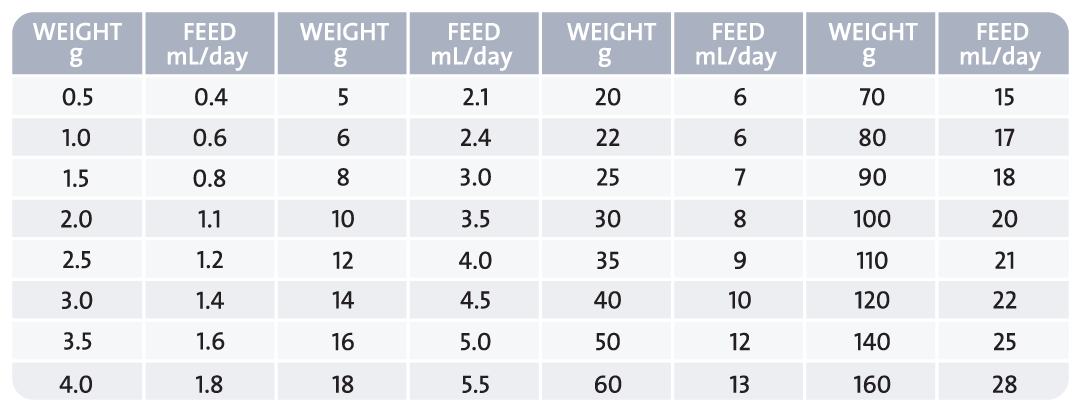Milk substitute for possum & glider joeys with less than 80% of their pouch life completed.
Joeys at this stage have furless pink skin to fine fur, eyes closed to just opened and ears drooped, or starting to become erect. Joeys are fully pouch-bound and totally dependent on milk. Faeces are yellow custard to toothpaste consistency.
Key Features
- Formulated to match the composition of early to mid lactation possum milk.
- Moderate energy milk, balancing carbohydrate & protein with a relatively low fat content.
- Protein high in sulphur-containing amino acids (cysteine & methionine) to promote good hair growth.
Vet Recommendation
“We have used and recommended the Wombaroo Possum Milk replacers for Brushtails, Squirrels and Sugar Gliders in Townsville extensively. Handling, mentoring & supervising about 250-300 animals a year. We would recommend the milks to all the members of the care group that we trained.” Eleanor & Jim Pollock (BVSc OAM).
Ingredients
Whole milk solids (low lactose), whey protein, casein, glucose, vegetable oils, omega-3 & 6 fatty acids, maltodextrin, vitamins A, B1, B2, B3, B5, B6, B9, B12, C, D3, E, K, biotin, choline, calcium, phosphorus, potassium, sodium, magnesium, zinc, iron, manganese, copper, iodine, selenium.
Typical Analysis
| Protein |
34% |
| Fat |
15% |
| Ash |
4% |
| Moisture |
3% |
| Energy (ME) |
19 MJ/kg |
Pack Sizes
160g & 800g.
Use Possum Milk Replacer <0.8 for pinkie and just-furring joeys, prior to pouch emergence. Furless possums and gliders are very prone to disease and mortality and should only be attempted by experienced carers with sufficient resources.
Impact Colostrum Supplement may be fed to enhance the immune system.
Making up Milk
To make 100mL of milk: Mix 16g of powder (2½ scoops) with 90ml of warm water.
To make 1 litre of milk: Mix 160g of powder with 900ml of warm water.
Add about half of the water to the powder first and mix to a paste. Then make up with remaining water and mix thoroughly. Water is preboiled to ensure that it is sterilised. If the water is too hot it can cause the milk to curdle. If it is too cold then it will be difficult to disperse the powder. An electric whisk can be used for mixing larger quantities. Milk can be stored in the fridge for a day or can be frozen for up to 2 weeks. It may be useful to store frozen milk in small portions (e.g. ice cube trays), so that the required daily feed volumes can be easily thawed out. Once thawed out, discard any unused milk, and wash feeding utensils thoroughly.
Feeding Guide

Warm milk to about 30°C and feed using a bottle and teat. A C Teat, P Teat or SD Teat is recommended for in-pouch possums & gliders. A syringe or eye dropper may be required for ringtails, pygmy possums or small gliders. Feed around 6-8 times per day for furless joeys, reducing this to 4 times per day by first pouch emergence. If the joey is showing signs of dehydration (e.g. during hot weather), give extra drinks of water between feeds. Joeys dehydrate rapidly if not maintained under optimum husbandry conditions. Consult your veterinarian or experienced carer for further information about husbandry and feeding of joeys.
Growth
Different species of possums and gliders grow at different rates. Refer to the Wombaroo growth charts for guidelines for various species. Weigh joeys regularly to verify weight gains and determine the volume of milk to feed. Overfeeding milk can cause diarrhoea so feed the suggested volumes in our tables.
Transitioning from Possum <0.8 to Possum >0.8 formula
Milk transition refers to when a joey is changed from one Wombaroo milk stage to the next. It is important to transition joeys at the correct age to ensure they are getting the proper nutrition for their stage of development. Note that transition is dependent on joey age and not weight, as underweight joeys still need to be transitioned at the correct time. Once possums are fully-furred and beginning to emerge from the pouch they are ready to transition on to Possum Milk Replacer >0.8 formula. Joeys are gradually transitioned over about 8-18 days (depending on species) by mixing decreasing amounts of the <0.8 formula with increasing amounts of the >0.8 formula. This is outlined in the Wombaroo growth charts for various species.








